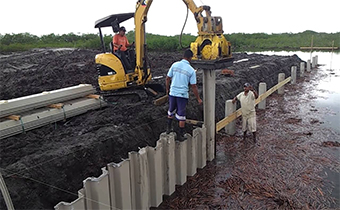Sheet Piling and Bored Piling
Sheet Piling is used to provide temporary and permanent walls in the construction industry. Sheet piling is also used as excavation support and for soil retention. It creates a border which keeps the soil back, away from the structure.
Bored piling is a method that involves boring a circular hole into the ground, installing steel reinforcement and filling the bore hole with concrete to form a pile. Boring is carried out to the design depth by means of either a crane mounted or a track mounted hydraulic drilling rigs.

”Bored piling is defined as the removal of soil by boring or excavation forms a void before reinforced concrete piles are produced while sheet piling is a form of driven piling using thin interlocking sheets of steel to obtain a continuous barrier in the ground. For the development of sheet piles, there are two main techniques: hot-rolled and cold-formed. At high temperatures, hot rolled piles are produced and the interlocks appear to be stronger and more resilient. The hot rolled piles are bigger than cold-formed piles and are heavier. Cold-formed piles will have looser interlocks and hard driving is not recommended.“
Sheet Piling
- Lifting crane shall be selected, based on the weight of the members to be lifted.
- Working access and area shall be good and wide enough for this type of work including swing operation.
- The lifting supervisor shall be assigned for the operation. Riggers, signalman and etc. shall be well organized. They shall be instructed clearly for the operation.
- Crawler crane shall park at the pre-determined positions. Sheet piles lay down area shall be selected at the early stage.
- Ensure the shackle has a valid LG certificate before used.
- The maximum hoisting capacity for shackle is 8 tons.
Bored Piling
- The construction starts by drilling a vertical hole into the soil using the bored piling machine. The machine is outfitted with accessories like drilling tools, buckets, and grabs that help remove soil and rocks during the drilling process.
- The piles drilled can go up to a depth of 60 m and a diameter of 2.4 m.
- A temporary steel cylinder or sleeve is inserted into the drilled hole until the pile is poured.
- After this, a rebar cage for the pile is inserted into the hole and, subsequently, filled with concrete.
- The top of the pile is capped either with a footing or a pile cap near the ground level so that the structure above can be constructed.
